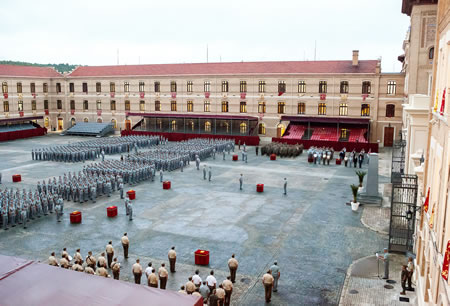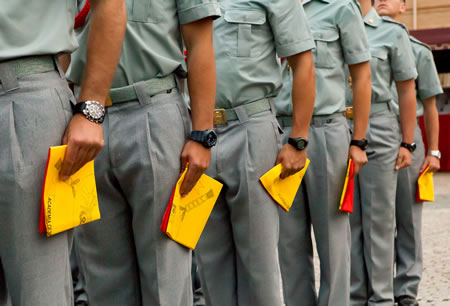- Home
- UNITS
- Zaragoza
- General Military Academy
- Parades and Ceremonies
- Entrega de Bandera de Percha
MENÚ UNIDAD
ARMY UNITS
- Araba Álava |
- Albacete |
- Alicante |
- Almería |
- Asturias |
- Ávila |
- Badajoz |
- Barcelona |
- Burgos |
- Cáceres |
- Cádiz |
- Cantabria |
- Castellón |
- Ceuta |
- Ciudad Real |
- Córdoba |
- A Coruña |
- Cuenca |
- Girona |
- Granada |
- Guadalajara |
- Gipuzkoa |
- Huelva |
- Huesca |
- Islas Baleares |
- Jaén |
- León |
- Lleida |
- Lugo |
- Madrid |
- Málaga |
- Melilla |
- Murcia |
- Navarra |
- Ourense |
- Palencia |
- Las Palmas |
- Pontevedra |
- La Rioja |
- Salamanca |
- Segovia |
- Sevilla |
- Soria |
- Tarragona |
- Santa Cruz de Tenerife |
- Teruel |
- Toledo |
- Valencia |
- Valladolid |
- Bizkaia |
- Zamora |
- Zaragoza

Parades and Ceremonies
The Handing-over of the Flag Drape
The Academia General Militar has recovered an old tradition: the handing-over of the Flag Drape. Every year since 2010, normally in October, this simple event has been held for all the new incoming personnel, from the Commandant to the last member of the Academia, who receive this symbol from their unit commander and which entails the belonging to a certain unit.
The Flag Drape or Field Flag dates back to the middle of 19th century and the beginning of 20th century, coinciding with the reigns of Alfonso XII and Alfonso XIII. Every soldier was given one and it was used to cover his belongings and equipment which were hanging from a sort of hanger or lying on a shelf over their beds, at a time in which there were no lockers or wardrobes.

Formation in the Parade Ground for the handing-over of the Flag Drape (Photo: AGM)
In the field, the Flag was kept inside the rucksack and it was used, properly unfurled, to signal the achievement of a goal, identify the units that fought closely and alert the units of the flanks and the ones from their own artillery.
The soldier, once discharged, kept it as a souvenir and membership of his Unit. It was a common custom for the soldier’s family to show their neighbours that their son or brother had fulfilled their duty and had happily returned home. This flag was used to embellish the houses of Spanish villages and cities on festivity days. This tradition still remains in many Spanish homes.

New incoming cadets receive the Flag Drape (Photo:AGM)
Finally, as last and sublime function, the flag drape was used to honor the soldiers fallen in combat, whose bodies were buried draped in their own national flag, as it corresponds to those who have died for Spain. It was in the African war where this piece of clothing became a romantic garment, which was popular in the military music: “… I only want to be buried with the Spanish Flag …” (although, as it seems, the original lyrics were: …I only want to be buried with my Spanish Flag)…”.
Its measures were 60 x 80 or 75 x 90 cm. The national coat of arms and the name of the unit used to be in parallel to the stripes. It was made in light material of poor textile quality, with laces in its ends to be tied up. At the beginning it was red, although later on it changed into the national colours. It didn’t have any fringe and it only had colours on one side, transferring the printing to the other side.
Our Army stopped using the Flag Drape in 1927.



